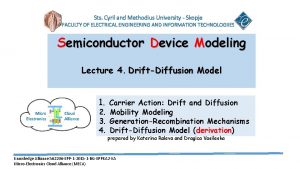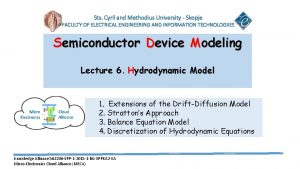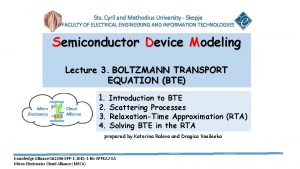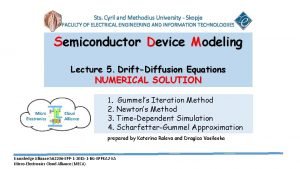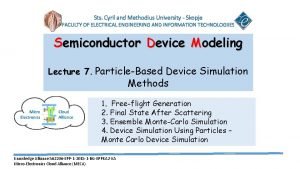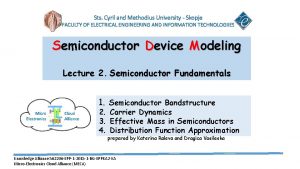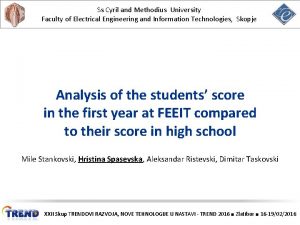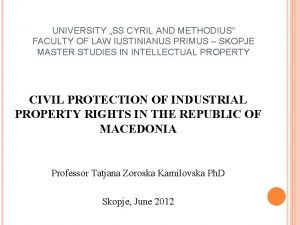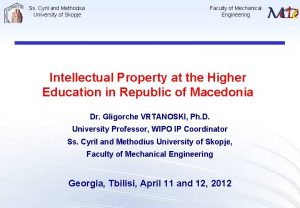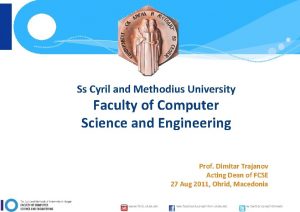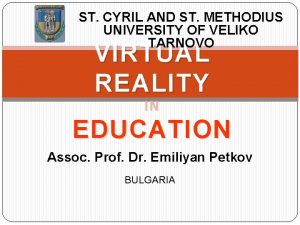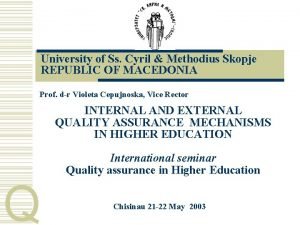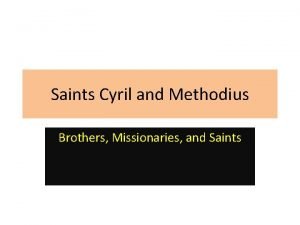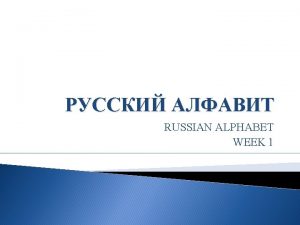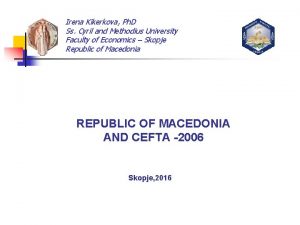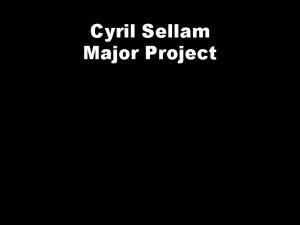Sts Cyril and Methodius University Faculty of Natural































- Slides: 31

Sts Cyril and Methodius University Faculty of Natural Sciences and Mathematics Institute of Physics P. O. Box 162, 1000 Skopje, Macedonia DESYNCHRONIZATION OF SYSTEMS OF HINDMARSH-ROSE OSCILLATORS BY VARIABLE TIME-DELAY FEEDBACK A. Gjurchinovski 1, V. Urumov 1 and Z. Vasilkoski 2 1 Institute of Physics, Sts Cyril and Methodius University, Skopje, Macedonia 2 Northeastern University, Boston, USA E-Mail: urumov@pmf. ukim. mk International Conference in Memory of Academician Matey Mateev – Sofia , 2011



CONTENTS I. Introduction 1. - Time-delay feedback control 2. - Variable-delay feedback control II. Stability of fixed points, periodic orbits - Ordinary differential equations - Delay-differential equations - Fractional-order differential equations III. Desynchronisation in systems of coupled oscillators IV. Conclusions

INTRODUCTION Time-delayed feedback control - generalizations • • Pyragas 1992 – Feedback proportional to the distance between the current state and the state one period in the past (TDAS) Socolar, Sukow, Gauthier 1994 – Improvement of the Pyragas scheme by using information from many previous states of the system – commensurate delays (ETDAS) Schuster, Stemmler 1997 – Variable gain Ahlborn, Parlitz 2004 – Multiple delay feedback with incommensurate delays (MDFC) Distributed delays (electrical engineering) Variable delays (mechanical engineering) Rosenblum, Pikovsky 2004 – Desynchronization of systems of oscillators with constant delay feedback E. Schoell and H. G. Schuster, eds. , Handbook of chaos control 2 ed. (Wiley-VCH, Weinheim, 2008)

VARIABLE DELAY FEEDBACK CONTROL OF USS The Lorenz system E. N. Lorenz, “Deterministic nonperiodic flow, ” J. Atmos. Sci. 20 (1963) 130. Fixed points: C 0 (0, 0, 0) C± (± 8. 485, 27) Eigenvalues: l(C 0) = {-22. 83, 11. 83, -2. 67} l(C±) = {-13. 85, 0. 09+10. 19 i, 0. 09 -10. 19 i} Chaotic attractor of the unperturbed system (F(t)=0)

VARIABLE DELAY FEEDBACK CONTROL OF USS Pyragas control force: - noninvasive for USS and periodic orbits VDFC force: - piezoelements, noise - saw tooth wave: - random wave: - sine wave: A. Gjurchinovski and V. Urumov – Europhys. Lett. 84, 40013 (2008)

VARIABLE DELAY FEEDBACK CONTROL OF USS

THE MECHANISM OF VDFC TDAS VDFC

STABILITY ANALYSIS - RDDE Retarded delay-differential equations Controlled RDDE system: u(t) – Pyragas-type feedback force with a variable time delay K T 2 f – feedback gain (strength of the feedback) – nominal delay value – periodic function with zero mean – amplitude of the modulation – frequency of the modulation A. Gjurchinovski, V. Urumov – Physical Review E 81, 016209 (2010)

EXAMPLES AND SIMULATIONS Mackey-Glass system • A model for regeneration of blood cells in patients with leukemia M. C. Mackey and L. Glass, Science 197, 28 (1977). • M-G system under variable-delay feedback control: • For the typical values a = 0. 2, b = 0. 1 and c = 10, the fixed points of the freerunning system are: • • • x 1 = 0 – unstable for any T 1, cannot be stabilized by VDFC x 2 = +1 – stable for T 1 [0, 4. 7082) x 3 = -1 – stable for T 1 [0, 4. 7082)

EXAMPLES AND SIMULATIONS Mackey-Glass system (without control) (a) T 1 = 4 (b) T 1 = 8 (c) T 1 = 15 (d) T 1 = 23

EXAMPLES AND SIMULATIONS Mackey-Glass system (VDFC) T 1 = 23 (a) = 0 (TDFC) (b) = 0. 5 (saw) (c) = 1 (saw) (d) = 2 (saw)

EXAMPLES AND SIMULATIONS Mackey-Glass system (VDFC) saw sin sqr T 1 = 23, T 2 = 18, K = 2, = 5

EXAMPLES AND SIMULATIONS Mackey-Glass system (VDFC)

FRACTIONAL DIFFERENTIAL EQUATIONS Fractional Rössler system Caputo fractional-order derivative: A. Gjurchinovski, T. Sandev and V. Urumov – J. Phys. A 43, 445102 (2010)

FRACTIONAL DIFFERENTIAL EQUATIONS Fractional Rössler system

FRACTIONAL DIFFERENTIAL EQUATIONS Fractional Rössler system - stability diagrams Time-delayed feedback control Variable delay feedback control (sine-wave, =10)

Kuramoto model of phase oscillators

Solution for the Kuramoto model (1975) solutions i

DEEP BRAIN STIMULATION • Delay - deliberately introduced to control pathological synchrony manifested in some diseases • Delay - due to signal propagation • Delay – due to self-feedback loop of neurovascular coupling in the brain

Hindmarsh-Rose oscillator

Desynchronisation in systems of coupled oscillators Hindmarsh - Rose oscillators M. Rosenblum and A. Pikovsky, Phys. Rev. Lett. 92, 114102; Phys. Rev. E 70, 041904 (2004) Global coupling Mean field Delayed feedback control

Desynchronisation in systems of coupled oscillators N=1000, tcont=5000, Kmf=0. 08, K=0. 15, =72. 5 No control TDFC VDFC ( = 40, = 10)

Desynchronisation in systems of coupled oscillators System of 1000 H-R oscillators Feedback switched on at t=5000 Kmf=0. 08 K=0. 0036 =const=72. 5

Desynchronisation in systems of coupled oscillators Mean field time-series TDFC VDFC ( = 40, = 10) =72. 5

Desynchronisation in systems of coupled oscillators N=1000, tcont=5000, Kmf=0. 08, K=0. 15, =116 No control TDFC VDFC ( = 40, = 10)

Desynchronisation in systems of coupled oscillators Mean field time-series TDFC VDFC ( = 40, = 10) =116

Desynchronisation in systems of coupled oscillators Time-delayed feedback control Variable delay feedback control (sine-wave, =40, =10, N=1000) X – Mean field in the absence of feedback Xf – Mean field in the presence of feedback Suppression coefficient T=145 – average period of the mean field in the absence of feedback

Desynchronisation in systems of coupled oscillators Multiple-delay feedback control (MDFC) – Ahlborn, Parlitz (2004) 2 K 1 = K 2 = 0. 06 Multiple-delay feedback control MDFC with variable delay (sine-wave, =40, =10)

CONCLUSIONS AND FUTURE PROSPECTS • Enlarged domain for stabilization of unstable steady states in systems of ordinary/delay/fractional differential equations in comparison with Pyragas method and its generalizations • Agreement between theory and simulations for large frequencies in the delay modulation • Variable delay feedback control provides increased robustness in achieving desynchronization in wider domain of parameter space in system of coupled Hindmarsh-Rose oscillators interacting through their mean field • The influence of variable-delay feedback in other systems (neutral DDE, PDE, networks, different oscillators, …) • Experimental verification
 Mendel university faculty of business and economics
Mendel university faculty of business and economics University of debrecen faculty of economics and business
University of debrecen faculty of economics and business Mendel university faculty of business and economics
Mendel university faculty of business and economics Herszon kherson maritime college of merchant marine fleet
Herszon kherson maritime college of merchant marine fleet University of bridgeport computer science faculty
University of bridgeport computer science faculty University of bridgeport computer science
University of bridgeport computer science Hubert kairuki memorial university faculty of medicine
Hubert kairuki memorial university faculty of medicine Semmelweis
Semmelweis King abdulaziz university faculty of medicine
King abdulaziz university faculty of medicine Fsu computer science department
Fsu computer science department Singularity executive program
Singularity executive program Semmelweis university faculty of medicine
Semmelweis university faculty of medicine Masaryk university medical faculty
Masaryk university medical faculty Feup university of porto
Feup university of porto Charles university faculty of humanities
Charles university faculty of humanities Faculty of veterinary medicine cairo university logo
Faculty of veterinary medicine cairo university logo Faculty of law of the university of zagreb
Faculty of law of the university of zagreb University of montenegro faculty of law
University of montenegro faculty of law University of kragujevac faculty of technical sciences
University of kragujevac faculty of technical sciences University of cologne faculty of management
University of cologne faculty of management Leading university faculty
Leading university faculty Hacettepe university faculty of medicine
Hacettepe university faculty of medicine Brown university computer science faculty
Brown university computer science faculty Auricle of heart vs atrium
Auricle of heart vs atrium Semmelweis university faculty of medicine
Semmelweis university faculty of medicine Ulfg2
Ulfg2 Myfile york
Myfile york Clemson university electrical engineering faculty
Clemson university electrical engineering faculty Faculty of veterinary medicine cairo university
Faculty of veterinary medicine cairo university Faculty of mechanical engineering thammasat university
Faculty of mechanical engineering thammasat university Chronic meningitis
Chronic meningitis Faculty of public health mahidol university
Faculty of public health mahidol university
































